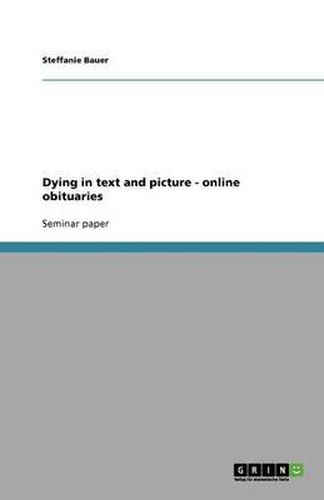Readings Newsletter
Become a Readings Member to make your shopping experience even easier.
Sign in or sign up for free!
You’re not far away from qualifying for FREE standard shipping within Australia
You’ve qualified for FREE standard shipping within Australia
The cart is loading…






Seminar paper from the year 2006 in the subject English Language and Literature Studies - Linguistics, grade: 1,0, Bielefeld University, language: English, abstract: Obituaries in newspapers and magazines are solemn, quiet affairs. But the new media offer a different kind of way of honoring a deceased loved one. You can publish articles, countless picture, interactive guest-books and other gimmicks. But a very popular means of mourning are slideshow obituaries. A few notes concerning terminology are necessary at this point. The term obituary is traditionally used for text-only formats (sometimes including a single picture) that appear in newspapers. The slideshow obituaries of our corpus are structurally as well as content-wise very different from these. Nonetheless, we use have the term as a starting point for our paper and will use it throughout our text. One can argue that a comparison between slideshow obituaries and traditional ones is impossible because of the high discrepancies in structure and content. But our reason for omitting such a comparison is based on the fact that an analysis of this kind would have to rely primarily on linguistic aspects. The numerous pictures in slideshow obituaries would be dealt with very briefly and which does not do justice to the prominent role they play in this particular kind of text. But the more of a slideshow obituary is not only the pictures. Other visuals play an important role, the layout, the hosting website. You have the freedom to use different fonts and font sizes. You can create everything from scratch or fall back on websites that provide design templates. You can add music or a voice message. The content is usually much less limited than that of a traditional obituary. This myriad of design possibilities leads to our hypothesis: we propose that, in slideshow obituaries, the different modalities - especially word and image - cannot be separated from one another. They fulfill inherently different functions and
$9.00 standard shipping within Australia
FREE standard shipping within Australia for orders over $100.00
Express & International shipping calculated at checkout
Seminar paper from the year 2006 in the subject English Language and Literature Studies - Linguistics, grade: 1,0, Bielefeld University, language: English, abstract: Obituaries in newspapers and magazines are solemn, quiet affairs. But the new media offer a different kind of way of honoring a deceased loved one. You can publish articles, countless picture, interactive guest-books and other gimmicks. But a very popular means of mourning are slideshow obituaries. A few notes concerning terminology are necessary at this point. The term obituary is traditionally used for text-only formats (sometimes including a single picture) that appear in newspapers. The slideshow obituaries of our corpus are structurally as well as content-wise very different from these. Nonetheless, we use have the term as a starting point for our paper and will use it throughout our text. One can argue that a comparison between slideshow obituaries and traditional ones is impossible because of the high discrepancies in structure and content. But our reason for omitting such a comparison is based on the fact that an analysis of this kind would have to rely primarily on linguistic aspects. The numerous pictures in slideshow obituaries would be dealt with very briefly and which does not do justice to the prominent role they play in this particular kind of text. But the more of a slideshow obituary is not only the pictures. Other visuals play an important role, the layout, the hosting website. You have the freedom to use different fonts and font sizes. You can create everything from scratch or fall back on websites that provide design templates. You can add music or a voice message. The content is usually much less limited than that of a traditional obituary. This myriad of design possibilities leads to our hypothesis: we propose that, in slideshow obituaries, the different modalities - especially word and image - cannot be separated from one another. They fulfill inherently different functions and